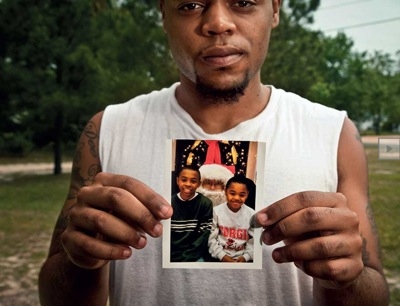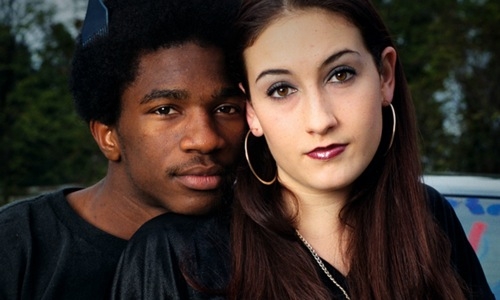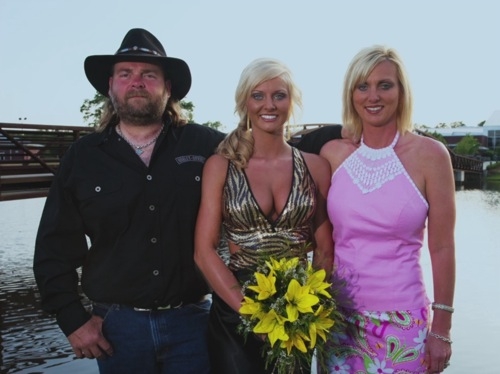Photographer Profile - Gillian Laub: "There were many times that I was threatened"

|
|
|
“You should go back to where you came from,” one of them said. “People here take the law into their own hands.”
“I said, ‘Is that a threat?’” recalls Laub. “And he said, ‘No it’s a warning.’”
Laub did leave, but she came back later, and continued coming back to southern Georgia again and again to follow a remarkable and ultimately tragic story about race and racism in America. What started as a magazine assignment to photograph segregated events at the local high school would evolve into a far more challenging personal project and a far more complicated narrative—a story about the killing of a young black man by an older white man and a town struggling toward progress in a culture embedded in the past.
The result is Laub’s first feature-length documentary film, Southern Rites, which debuts on Monday, May 18, on HBO. Accompanying the film is a book, also called Southern Rites, and an exhibition opening on May 14 at New York City’s Benrubi Gallery.
The film takes what Details magazine rightly calls “an unvarnished, hyperlocal look at the racial tensions roiling the United States.” The timing of its premiere, coming amid a national conversation about the racial divide in America's justice system, adds to its impact. But it’s not the kind of story that can be tidily summed up as a social issue, nor are the people in it easily understood as bad and good. Laub reveals the realities of Montgomery County and its residents in layers that are peeled back as the story moves in several different directions. The film’s structure represents Laub’s own experience in Georgia.
“I didn’t know when I started that this would end up taking the form of a film,” she says. “But I was determined to tell the story, not knowing exactly what it was or where it was going.”
A Tale of Two Proms
Laub, who grew up in the town of Chappaqua, north of New York City, and studied at the International Center of Photography, recently joined the Reportage by Getty Images roster of photographers. But in 2002 she was just launching a freelance career when Spin magazine assigned her to travel to Montgomery County. The editors had received a letter from a black high-school student there explaining that the school, though integrated, held separate proms for black and white students.
“It was a cry for help, really,” says Laub. “The letter said, ‘Please, please, please show what’s going on here—it’s outrageous. I can’t take my boyfriend to the prom; he’s black and I’m white.”’
Laub says she was fascinated by what she found during the trip. “On the one hand, the town seemed so friendly and integrated,” she says, “but there was a dissonance because I’d never seen a place with such overt displays of racism.”

After
completing the assignment, Laub immediately launched herself on a long-term personal project examining life in Israel following the Second Intifada. The work spanned five years and eventually resulted
in Laub’s first monograph, Testimony. But during the time she was in the Middle East, she kept thinking about what she’d seen in Georgia. “It haunted me, and I knew I had to
go back there,” she says.
In 2008, she got her chance. Back in New York, she learned that the school was still holding separate proms for white and black students.
Laub pitched a new story to the New York Times Magazine, which sent her back to Georgia to photograph the school’s white prom. She went, but was soon recognized by a parent who remembered her from 2002. That’s when she was confronted at the local Ruby Tuesday.
“Unfortunately, I got chased out of town,” she says. But she returned later to photograph the black prom, where she was welcomed.
A Nuanced Story
In 2009, Laub traveled to Georgia again, this time getting access to a number of white students and their parents. After her images of the two proms finally ran in the New York Times Magazine, the Montgomery County high school, facing widespread criticism, changed its policy of holding separate events. Laub wanted to go back. “I knew that proms were just a symptom of something larger, and I knew it was important for me to cover the first integrated prom,” she says.
But she also felt that her photographs were not telling the entire story about the town. “Showing beautiful kids in prom dresses didn’t give whole context,” she says. “I didn’t know how to make a film, but I felt like the story necessitated that.”
So Laub took a filmmaking course offered by the MediaStorm production studio in New York, and in 2010 she returned to Georgia. “I just started following different people and collecting different stories,” she says. She was aided by a black girl she had met named Keyke Burns, the daughter of the local police chief.
“They were so nice to me, and really took me in,” Laub says. Calvin Burns, who had been working in law enforcement for 30 years, told her that his dream was to run for county sheriff. He’d considered doing it a couple of years before but decided against it after receiving death threats. Now he had more support and was going to run. “And I thought, ‘Wait, this black man is running for sheriff here, and the school has stopped having segregated proms—this is a story of hope,’ says Laub. “I thought that maybe I could tell the real story of this town through Keyke’s eyes.”
But the town’s racial divisions were still very much real.

“There were many times that I was threatened and bullied, and clearly people didn’t want me there,” says Laub. “I would come home and the producer I was working with would say, ‘These are horrible stories, but if you don’t have it captured on film, it didn’t happen. You have every right to be filming and photographing.’”
Though she had gotten permission to photograph the 2010 integrated prom, she found herself being escorted away from the event. And in 2011, when she was filming at the high school’s homecoming parade, the Montgomery County sheriff approached her car. The moment in the film is chilling.
“I said to myself, ‘Okay, this time I’m just letting the camera roll, they can’t scare me anymore. I know my rights,’” says Laub. “But he just came after me, saying, ‘Give me that film, give me that film.’ He grabbed my camera, so I struggled with him. In the documentary, you see the picture go white, because he ripped the lens off the camera. But I managed with my finger to pop the memory card out, and it went under the seat. So I gave him my camera. Then he pulled me out of the car and handcuffed me. I was screaming and begging him to let me go, because if I were arrested at that time, it would have been a disaster.” She was released, and the sheriff kept the camera. But Laub had the card.
Then, one day, Laub received a call from Keyke Burns. “She told me that the boyfriend she’d had in high school—they’d gone to the prom together in 2007 but broken up shortly afterward—had been killed,” Laub says.
A Dramatic Courthouse Scene
Justin Patterson, 22, had been shot by a man named Norman Neesmith. Patterson and his brother had been in Neesmith’s home, paying a late-night visit to Neesmith’s daughter and one of her friends—what Neesmith’s lawyer would later term a “booty call.” Neesmith’s daughter had invited Patterson into the home; Neesmith said he was unaware of that—that when he awoke to find the two young men in his house, he ordered them to leave and had been defending himself when he shot.
As it explores the killing and its aftermath, Laub’s film becomes something more than an expose of small-town bigotry. Neesmith is a complex character who speaks freely and revealingly on film; his own story, and the story of his relationship with his daughter, confound viewers’ expectations.
It all unfolds in a dramatic courthouse scene and a riveting interview with a young woman in which matters of racial prejudice, family loyalty and personal guilt are played out in the most personal terms. The film about segregated proms and the election of a sheriff always circles back to Justin Patterson and Norman Neesmith.
In doing so, it reflects Laub’s approach to storytelling. “All my projects are about my own discovery,” she says. “I don’t know the outcome of anything when I start. What’s the point if you’re not there to learn something?”


